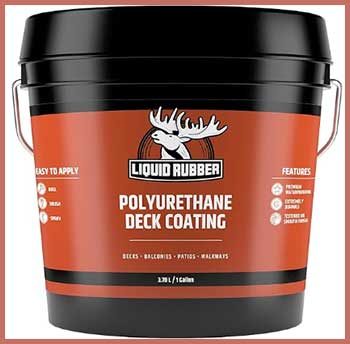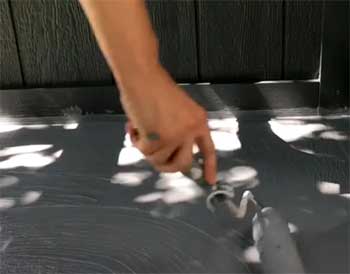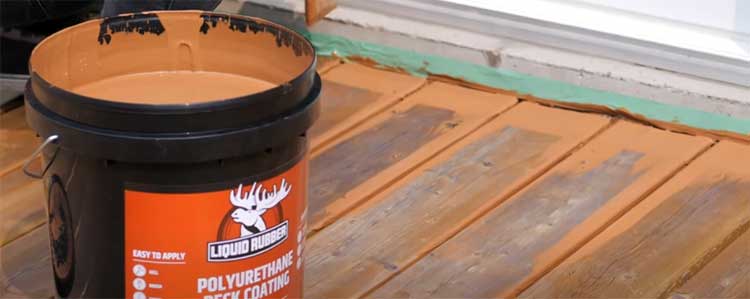I recently discovered Liquid Rubber Polyurethane Deck Coating, and it’s been a game changer for my aging deck. If you’re considering a waterproof, durable, and attractive solution for your outdoor spaces, I highly recommend giving this product a try. Its ease of application and remarkable finish have truly won me over.
Let’s explore my journey with Liquid Rubber, its benefits and drawbacks, maintenance tips, and how it compares with other brands on the market.
My Journey With Liquid Rubber Deck Coating
I remember when I first noticed my deck showing signs of wear. The old stain had begun peeling, and the wood was no longer as inviting as it once was. I was frustrated by previous attempts with other coatings that either didn’t last or required constant upkeep.

That’s when I decided to try Liquid Rubber.
I was drawn to its promise of a waterproof, durable, and UV-stable finish that could transform an aging deck into something that looks almost brand new.
The application process was surprisingly straightforward.
I chose to apply the coating with a conventional brush for the railings and a microfiber roller for the flat deck areas.
The coating’s thickness meant that it did not drip off the tools, which was a pleasant surprise given my past experiences with runny paints. The product was forgiving yet resilient, allowing me to cover up imperfections while providing a consistent finish that enhanced the deck’s texture.
In the process of using Liquid Rubber, I learned a lot about what makes a quality deck coating stand out. From its easy application to its impressive waterproof barrier, every step of the process confirmed that I had made the right choice for my home improvement project.
I’m excited to share my insights on this product, including the pros and cons, as well as tips to get the most out of it.
The Pros of Liquid Rubber Deck Coating
- Exceptional Durability and Waterproofing: One of the standout features for me has been the coating’s durability. Liquid Rubber forms a hard, resilient surface that not only protects my deck from water damage but also withstands heavy foot traffic and the movement of patio furniture. Over time, I’ve seen minimal wear even after repeated use and exposure to the elements. The waterproof barrier has been especially useful, preventing moisture from seeping into the wood and causing rot.
- Ease of Application: I was impressed by how smoothly the product spread over the deck. Its thick consistency ensures that it stays where you put it, reducing the mess typically associated with thinner paints. Whether you’re using a brush or a microfiber roller, the application is uniform and straightforward. I found that even as someone who isn’t a professional painter, I could achieve a high-quality finish with minimal hassle.
- UV Stability and Heat Resistance: Another benefit that caught my eye is the excellent UV stability. My deck is exposed to direct sunlight for long hours, and I was concerned about the effects of UV radiation on any coating. Liquid Rubber’s formulation includes properties that resist UV damage, meaning the color remains vibrant, and the surface integrity stays intact, even under intense sun exposure.
- Versatility in Application: Liquid Rubber isn’t just for wooden decks. I’ve seen it used on concrete walkways, pool decks, and even indoor floors. This versatility makes it a smart investment if you’re looking to protect multiple surfaces around your home. Its ability to adhere well to different substrates means that no matter what material your outdoor space is made of, you can trust this coating to deliver a robust finish.
- Quick Drying and Easy Cleanup: The drying time for Liquid Rubber is quite reasonable, and I was pleased to see that once it dried, the cleanup was effortless. Despite its thick consistency, the product cleans up quickly, which is a boon if you’re working on a time-sensitive project. The minimal cleanup requirement means less stress and more time enjoying your newly renovated deck.
The Cons of Liquid Rubber Deck Coating

- Application Temperature Sensitivity: While Liquid Rubber offers many benefits, there are a few considerations to keep in mind. One challenge I encountered was the temperature sensitivity during application. The product needs to be applied above 10 degrees Celsius (50°F) and should not be used when dew or rain is expected within 24 hours. This means planning your project around the weather, which can be a bit of a hassle if you live in a region with unpredictable conditions.
- Limited Color Options in Some Cases: At first, I was a bit disappointed to find that not all colors were readily available in larger quantities like five-gallon buckets. In my case, the color that matched my house’s siding wasn’t available immediately. I had to wait for the product to be back in stock, which can be a minor inconvenience if you’re on a tight schedule. However, once the right color was available, the wait was definitely worth it.
- The Learning Curve for Proper Coverage: Another aspect that I had to navigate was the learning curve associated with achieving the best coverage. While the product is easy to apply, ensuring even coverage on surfaces with deep cracks or imperfections may require multiple generous coats. For high-traffic areas, the recommendation is to use more coats, which could mean extra time and product. This is something to be mindful of, especially if you’re looking for a quick weekend project.
How To Get The Most Out of Liquid Rubber?
- Pre-Application Preparation: To ensure you get the best results from Liquid Rubber, preparation is key. I started by thoroughly cleaning the deck with a hose and a mild detergent. Removing dirt, old stains, and any loose debris is crucial because the coating adheres best to a clean surface. In areas with stubborn grime or mildew, I used a pressure washer at a moderate setting. I recommend spending a little extra time on this step, as it makes a significant difference in the overall finish and longevity of the coating.
- Proper Application Techniques: When I began applying the coating, I followed the manufacturer’s recommendations closely. I started with a primer coat using a brush on areas that were particularly challenging, such as railings and edges. For the larger, flat areas of the deck, a microfiber roller with a 3/8 (10mm) nap worked wonders. The key here is to apply 3-4 generous coats on most areas, and 4-5 coats in high traffic zones. I learned that patience is essential—don’t rush the process. Allow each coat to dry completely before moving on to the next one, which usually takes a few hours, depending on the ambient temperature.
- Tools and Techniques: Investing in quality tools made a big difference in my experience. I opted for a high-quality brush for the intricate parts and a roller with a thicker nap for textured application. I found that the thicker nap added a slight texture to the deck, which not only improved the grip but also gave the surface an attractive finish. Cleaning your tools right after the application is vital, as the coating can harden and make cleanup more challenging later on.
- Regular Maintenance for Longevity: Even though Liquid Rubber is designed to last, regular maintenance can help extend its life further. I recommend doing an annual inspection of your deck, especially after harsh weather conditions. Look for any signs of wear, peeling, or cracks. If you notice any imperfections, a touch-up with a small amount of the coating can keep your deck looking pristine. Also, keep an eye on areas that experience heavy use, as they might require more frequent attention.
- Handling Repairs and Touch-Ups: One of the things I appreciate most is how easy it is to perform repairs. Unlike other coatings that might require complete removal and reapplication, Liquid Rubber allows for spot repairs. If you notice a small area where the coating has worn thin or started to peel, simply clean the area, lightly sand it if needed, and apply an extra coat. This flexibility means you can maintain your deck’s appearance without undertaking a full-scale project each time.
Comparison of Liquid Rubber Deck Coating With Other Deck Coatings
When I began exploring deck coatings, I tried a few different brands before settling on Liquid Rubber. Here’s how it compares to other options on the market:
- Traditional Deck Stains: Traditional deck stains have been my go-to in the past, but they often fall short in terms of longevity and ease of application. Stains typically require frequent reapplications, and their protection against moisture is less robust. In contrast, Liquid Rubber provides a waterproof barrier that lasts longer and requires less maintenance. The thick consistency of Liquid Rubber also means it fills in cracks and creates a uniform appearance, which stains can’t always achieve.
- Elastomeric Coatings: I experimented with elastomeric coatings on a previous project. While these coatings offer flexibility and a degree of waterproofing, they often lack the UV stability and durability that Liquid Rubber provides. Elastomeric coatings can sometimes be too elastic, leading to a finish that feels less firm underfoot. On the other hand, Liquid Rubber dries to a hard, plastic-like finish that resists abrasion and stands up to heavy use without becoming slippery.
- Epoxy Coatings: Epoxy coatings are known for their toughness, but they are usually more suited for indoor use or specialized applications like garage floors. Epoxy can be quite rigid and may crack when exposed to the natural expansion and contraction of wood decks. Liquid Rubber, being a polyurethane-based product, strikes a balance between rigidity and flexibility, making it more adaptable to the dynamic nature of outdoor decking materials.
- Other Polyurethane Coatings: While there are other polyurethane coatings available, many fall short in either ease of application or long-term durability. I’ve tried a couple of different brands, and none of them delivered the combination of UV stability, waterproofing, and user-friendly application that Liquid Rubber offers. The fact that it is versatile enough for both wood and concrete surfaces gives it a unique edge over many competitors.
My Personal Experience: From Skepticism To Satisfaction

Before trying Liquid Rubber, I was skeptical. My previous experiences with deck coatings had left me wary of promises that sounded too good to be true.
I had battled with substandard products that either peeled away after a short time or left my deck looking worse than before. However, Liquid Rubber surprised me right from the start.
I began with a simple project: my deck had several years of wear and tear, including peeling stains and visible cracks. After a thorough cleaning and some minor repairs to ensure the wood was stable, I applied a primer coat on the railings with a brush.
The brush worked well on those hard-to-reach spots, and I was relieved to see that the coating did not drip or run off. For the main deck area, I switched to a microfiber roller with a thicker nap.
This not only allowed me to cover the surface evenly but also added a subtle texture that made the deck less slippery—a critical factor for safety, especially during hot summer days when bare feet are on the line.
As I applied the recommended three to four generous coats on most areas, I appreciated the consistent progress. With every additional coat, the imperfections from the old stain and weathering became less noticeable.
It felt as if I was watching my deck transform before my eyes. Even in the areas that experienced heavy foot traffic, the coating held strong, resisting scratches and abrasion from moving furniture and daily use.
What really stood out was how easily I could clean up after the project. Despite the product’s thickness, any residue or accidental drips were easily washed away with water and a bit of detergent.
This ease of cleanup was a significant improvement over previous coatings I had used, which often left me spending extra hours scrubbing tools and equipment.
During the process, I did encounter a few hiccups. On one occasion, I applied a coat during a day when the temperature dipped too close to the lower limit recommended for application. The drying time was a bit prolonged, and I had to wait longer than usual between coats.
This taught me the importance of carefully reading the application guidelines and planning the project around favorable weather conditions.
Additionally, while I did experience a delay in obtaining the exact color that matched my siding, the company’s prompt customer service resolved the issue quickly. I received a replacement bucket without hassle, which reinforced my trust in the brand.
It’s these little details—the responsive support, the robust product performance, and the ease of application—that turned my initial skepticism into genuine satisfaction.
Frequently Asked Questions (FAQ)
From my experience and research, a properly applied Liquid Rubber deck coating can last several years—often between 5 to 10 years—depending on weather conditions and usage. Regular inspections and maintenance can help maximize its lifespan.
Absolutely. Liquid Rubber is excellent for decking because it provides a hard, durable, and waterproof finish. Its UV stability and resistance to heavy traffic make it ideal for both wood and concrete surfaces, offering protection and an enhanced aesthetic appeal.
In my opinion, Liquid Rubber stands out as one of the best coatings for wood decks. It not only protects against water and UV damage but also creates a visually appealing finish that transforms the look of the wood, making it seem almost like a composite material.
When applied correctly and maintained well, Liquid Rubber waterproofing can last for many years. Based on my experience, you can expect it to provide effective waterproofing for around 5 to 10 years, although high traffic areas might require more frequent touch-ups.
Wrapping Up
Liquid Rubber has transformed my deck into a durable, waterproof, and visually stunning space that I can enjoy year after year. If you’re looking for a reliable and cost-effective solution that combines ease of application with long-lasting protection, give Liquid Rubber a try—you won’t be disappointed.

Do you know if a polyurethane coating can be applied over cool feet liquid rubber ?
Thank you